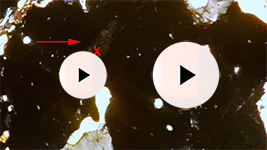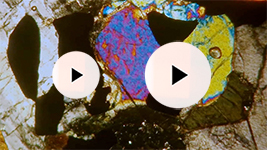
Interference colour. How is it formed?
4 polariser + anisotropic mineral (general cut in position of coincidence) + analyser
What happens if an anisotropic crystal is placed in the position of
coincidence?
It may be that when an anisotropic crystal, cut in a general position, is placed under the microscope, its directions of vibration coincide with those of the polariser and analyser (part 1 of the figure) and the effect is the same as for an isotropic crystal (as shown in the previous screen, corresponding to part 2 of the figure). In this case, it is said that the crystal is in the extinction position. All isotropic materials (cubic minerals and glass) will be appear black whenever observed in crossed-polarised light. Only special sections of anisotropic minerals have this property.



If the stage is rotated through 360°, there are four positions in which the two vibration directions of the mineral are parallel to those of the polariser and analyser. In general therefore, all anisotropic minerals will go black (or will extinguish) in these four positions (as shown in the previous screen, there are special sections of anysotropic minerals that remain black when the stage is rotated 360°).
As we know the directions of vibration of the nicols (E-W for the polariser and N-S for the analyser), we can also find out the directions of vibration of any crystal when it is in the extinction position (movie 3).
But what happens between the extinction positions?
Index | Introduction | PPL | XPL ortos | Interf colour | Int. c. formed? | Previous | Next